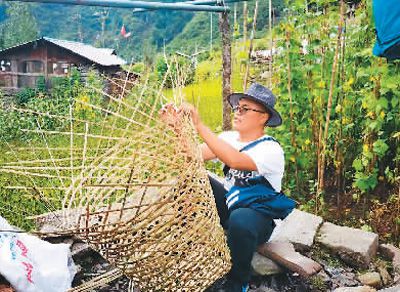Residents in China's border regions experience enhanced quality of life
Thanks to various efforts, China's border regions have witnessed rapid development in recent years, leading to a more prosperous life for the people there.
In Dawantang village, Mengding township, in Gengma Dai and Wa Autonomous County of Lincang city in southwest China's Yunnan Province, infrastructure was once poor, according to Li Yuzhen, a local villager. In 2003, her family lived in a thatched cottage.

Photo shows Li Yuzhen, a villager from Dawantang village, Mengding township, Gengma Dai and Wa Autonomous County, Lincang city, in southwest China's Yunnan Province. (Photo courtesy of the interviewee)
In 2019, Lincang launched a program targeting underdeveloped villages, transforming Dawantang village. A square, themed around the local Water Splashing Festival and featuring vibrant colors and a white pagoda, was built at the village entrance.
Residential buildings in the village have been standardized and renovated, incorporating elements of local culture. Cement roads have replaced muddy ones.
The village has worked to develop various industries, such as growing rubber, jackfruits, nuts, and vegetables. In 2022, the per capita disposable income of permanent residents in the village exceeded 20,000 yuan ($2,800).
Beiji village, or "North Pole Village," in Mohe city, northeast China's Heilongjiang Province, is a riverside border village located in the Greater Hinggan Mountains. Known for its ice, snow, and forests, the village is a year-round tourist attraction.

Photo shows Shi Ruijuan, who runs a homestay hotel in Beiji village, Mohe city, northeast China's Heilongjiang Province. (Photo courtesy of the interviewee)
Shi Ruijuan, a local villager, operates a homestay hotel. Each of her seven rooms is fully booked every day. "Earning 100,000 yuan in one winter was unthinkable a few years ago, but now it has become a reality," she said.
Shi has expanded her business beyond just providing accommodation. She creates travel itineraries for tourists, leveraging her knowledge of local attractions, and offers car rental services. These additions not only enhance the travel experience for visitors but also provide Shi with additional income.
The only problem with the hotel is its limited capacity. Shi plans to renovate the hotel, expand its size, add more rooms, and even start a hotel chain in the city. Recognizing a growing demand for high-end accommodation, she is also considering venturing into mid-to-high-end homestay hotels to cater to various customer groups.
Shi is also considering establishing a homestay hotel association in Beiji village. This association would unite nearly 200 homestays in the village, integrating their resources and advantages to better serve visitors and promote the village's development.
Drenthang township, located at the southern foothills of the Himalayas in Dinggye county, Xigaze city, in southwest China's Xizang Autonomous Region, was once known as the "last landlocked island in China" due to its limited transportation and poor power supply.
By the end of 2017, the first road to Drenthang township was opened, significantly improving travel for local residents.
The township's electricity problem has also been fully addressed, with its grid now connected to the national power grid.
Following these improvements, Drenthang township began developing its tourism industry, capitalizing on its scenic features such as snow-capped mountains, glaciers, hot springs, ancient temples, and Sherpa culture. This development has allowed local residents to benefit from the growing tourism sector.

Photo shows Penpa, a government worker in Drenthang township, Dingkye county, Xigaze city, in southwest China's Xizang Autonomous Region. (Photo courtesy of the interviewee)
Penpa, a government worker in Drenthang township, has observed significant changes over the years. In addition to his regular duties, he and his colleagues also patrol the border area. Despite harsh weather conditions, they remain committed to protecting their homeland.
Ji'an city in northeast China's Jilin Province has a tradition of growing wild grapes and producing ice wine. As fresh snow covers Ji'an, ripe clusters of deep purple grapes are ready for harvest.
Local winemaker Liu Guolin's family began grape cultivation 12 years ago, initially selling grape juice and unprocessed wine, but the profits were modest. Liu decided to study winemaking in Bordeaux, France.

Photo shows Liu Guolin, a winemaker in Ji'an city, in northeast China's Jilin Province. (Photo courtesy of the interviewee)
After seven years in France, Liu returned home and dedicated himself to researching and developing wine production. He focused on creating new products and exploring new processes. His efforts paid off, with his business experiencing significant annual revenue growth, exceeding 2 million yuan in 2022.
A few days ago, the Yalu River Ice Grape Wine Festival began. Chinese and foreign experts, as well as tourists, gathered to sample the ice wine. "With the platform provided by the government, winemakers can introduce our ice wine to a broader audience, allowing more people to taste the exquisite flavors from our border city," Liu said.
In Wensu county, Aksu Prefecture, in northwest China's Xinjiang Uygur Autonomous Region, two walnut growers have prospered through their cultivation efforts and developed a deep friendship.
Zhao Wuzhong, one of the growers, moved to Wensu with his family 27 years ago. He leased 35 mu (2.33 hectares) of land and became acquainted with fellow farmer Muhtar Turdi, who often helped him.

Photo shows Zhao Wuzhong (right) and Muhtar Turdi, walnut growers in Wensu county, Aksu Prefecture, in northwest China's Xinjiang Uygur Autonomous Region. (Photo courtesy of the interviewee)
However, a sandstorm in the spring of 2002 devastated Zhao's sapling orchard, threatening his family's livelihood. Despondent, Zhao considered returning to his hometown. But Muhtar Turdi encouraged him to persevere. "He gave me 10,000 yuan to buy fertilizer and shared his planting and management techniques with me," Zhao recalled. By 2007, Zhao's walnut income had reached 100,000 yuan, and in good years, it could rise to as much as 400,000 yuan. "I couldn't have achieved this without his selfless help," Zhao said gratefully.
Meanwhile, Muhtar Turdi struggled with low yields due to outdated walnut varieties. Zhao suggested a grafting process for new, high-density varieties and helped his friend with the grafting and management of the orchard. Three years later, the yield of walnuts per mu in Muhtar Turdi's orchard had tripled.
A newly established cooperative in Damao Banner, Baotou City, in north China's Inner Mongolia Autonomous Region, has helped expand sales channels for mutton, bringing increased wealth to local herders.

Photo shows Naimenhua, a herder in Damao Banner, Baotou city, north China's Inner Mongolia Autonomous Region. (Photo courtesy of the interviewee)
Herder Naimenhua’s family primarily relies on over 8,000 mu of natural pastureland, more than 200 sheep, and over 50 cattle. In the past, the family faced challenges selling their mutton due to limited sales channels, often dealing with intermediaries who drove down prices.
However, in April 2023, a cooperative was established. By collectively managing the processing, storage, transportation, and marketing of free-range mutton, the cooperative has allowed herder members to obtain fairer pricing.
Initially skeptical, Naimenhua tentatively invested in 20 sheep shares as a trial this spring and was pleasantly surprised to receive a dividend of 1,600 yuan. To date, the cooperative has sold 680 boxes of mutton, totaling 3,400 kilograms, bringing the natural taste of the grassland to consumers in Beijing and Shanghai.
Photos
Related Stories
Copyright © 2024 People's Daily Online. All Rights Reserved.









